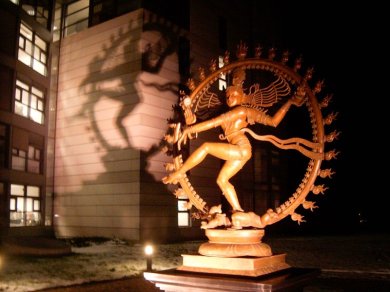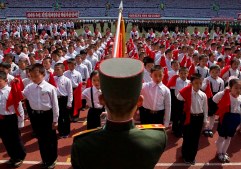![newsovietman[1]](https://thereluctantsamizdatwordpresscom.files.wordpress.com/2016/03/newsovietman1.jpg?w=529)
The New Soviet Man will be a “a higher social biologic type, or, if you please, a superman”.
Leon Trotsky
The ‘Superman’ has always been s dream of scientific society. 19th Century philosopher Frederick Nietzsche argued the ‘death of (the idea of) God’ meant we needed a ‘Übermensch’ – a being ‘beyond’ or ‘above’ being. This superman replaces the transcendent God and provides ultimate meaning and guidance. Many later followers of Nietzsche believed this happened through science, especially Eugenics . They argued that by controlling genetic inheritance, scientists could help create a new ‘God’. What the historical period of the Enlightenment had temporarily separated, Western culture has slowly being drawing back together- a blending of the roles of Priest-Magicians and Scientists. The revolutionary Trotsky’s ideal of a ‘higher biologic type’ was part of this desire. The fruit of this union of spirituality and science would be divine. In Trotsky’s case a socialist ‘God-man’.
I and others have long thought about this process of Convergence taking place in the power centers of our culture. It explains the otherwise puzzling spectacle of Emergent Christian Phyllis Tickle exhorting theology students “You want to go to seminary in the 21st century? Study physics first” .
C.S.Lewis’s “That Hideous Strength”, published over 60 years ago, describes exactly this process: scientists allied with dark spiritual forces working to create the ‘Superman’. First scientists had to become more and more open to alternative spirituality and less sure of what the idea of an objective truth:
“The physical sciences, good and innocent in themselves, had already…begun to be warped, had been subtly manoeuvred in a certain direction. Despair of objective truth had been increasingly insinuated into the scientists; indifference to it, and a concentration upon mere power, had been the result…you could not have done it with nineteenth – century scientists. their firm objective materialism would have excluded it from their minds; and their inherited morality would have kept them from touching dirt” (That Hideous Strength ch.9, p.120-121)
Philip E. Johnson comments on Lewis’s foresight in his excellent article here in First Things:
“Most futuristic novels seem “out of date” after a decade or two, but That Hideous Strength is more timely today than when the book was published in 1945. On the day I began to re-read the book for this essay, the press reported that a British government agency called the Human Fertilization and Embryological Authority (HFEA) is sounding out public opinion about the use of “Pre-implantation Genetic Diagnosis”, which will allow parents to screen their embryos for genetic defects. Critics believe that the HFEA has already decided to go full steam ahead with the procedure, and they don’t believe the Authority’s assurances that this technique (and others to follow) will be used only to screen for genetic diseases like cystic fibrosis and not to produce “designer babies.”
My suspicion that the critics are right was bolstered by an article appearing on the Web the same day from the Center for Bioethics at the University of Pennsylvania, titled “What is Immoral About Eugenics?” The article’s bottom line was that the use of genetic technology to produce the kind of children parents want, up to and including “eyebrow shape or freckle pattern,” should be allowed if the parents are not coerced and the children are not thereby disadvantaged. The role of ethics commissions in these situations is mainly to legitimate what the technocrats want to happen “namely, a reengineering of the human genome to improve the breeding stock. And why not, if the existing genome is merely the accidental product of mindless material forces? Since our ideas about ethics or the sanctity of life are also assumed to be products of genetic or brain chemistry, there is no reason to let them get in the way of progress.
In C. S. Lewis’ novel, the technological super-agency is the National Institute of Coordinated Experiments (NICE), which is empowered to solve all sorts of social and genetic problems without being bothered by “red tape.”
The NICE turns out to be demonic in inspiration, and intends to impose upon England a regime of ruthless social engineering that Joseph Stalin would have admired. The apparent “Head” at the NICE’s mansion at Belbury is the head of a guillotined murderer, kept alive with advanced life support systems, but this gruesome object is merely the conduit for orders from the dark powers…“In us organic life has produced Mind. It has done its work. After that we want no more of it.”
Does that sound far-fetched? Artificial intelligence visionaries are keen to make it a reality. While the biologists make plans to reprogram the human genome, the cyber gurus dream of uploading the human mind into advanced computers. Freed of the limitations of biology and possessed of superhuman intelligence, these “spiritual machines” might explore and conquer the cosmos. Or they might not bother to do so, since they could create a virtual reality for themselves that would be better than the real thing. Then “we” would truly be like God.”
This blending of spirituality and science is at work in many places. One is the Large Hadron Collider, under the Swiss Alps near Geneva. The scientists there are on a quest for the ‘God Particle’. It seems they have made a slightly different discovery. Apart from particles colliding at up to now impossible speeds: they have found religion.
Before you check the Vatican Twitter account or the Christian Coalition’s webpage, it may not be quite what you think. It is one side of the convergence I described in action. Thirty years ago Lesslie Newbigin in his book “Foolishness to the Greeks” also foresaw this process. Like Lewis, he recognised a coming together of science and spirituality that will more and more present itself as the legitimate spirituality for our times. He focussed on physics as one the forefronts of this type of convergence:
“it is common knowledge that the distinguished exponents of the new physics…are impressed by the similarities between this view of reality and the one found in Eastern religions. Fritjof Capra’s much-praised book The Tao of Physics sees the cosmic dance as the clue to the nature of the physical world, and the cover of his book is adorned with the well known image of the dancing Shiva.”
A search of CERN’s website (describing the function and aims of the Hadron Collider) for the Hindu God Shiva produces no results. Nevertheless, a giant statue of Shiva stands outside their building as their symbol. As if to emphasize its importance it is two meters high!

When asked about this the CERN scientists insisted it was ‘just a gift’ saying ‘there are many other artworks in the complex’. The statue of Shiva is, however, gigantic and is obviously more than just another artistic adornment, like watercolours or some quaint ceramic vases!
The significance of Shiva and mystical spirituality in general for these physicists is further highlighted by the mystical ‘dance of destruction’ that was filmed within the Hadron Collider complex. It shows Scientists interacting with something spiritual. Newbigin sums up his views about why physicists would be so attracted to this type of spirituality:
“The reason is clear. The Eastern religions do not understand the world in terms of purpose. The symbol of the dance is an interpretation of movement and change without invoking the idea of purpose. The Bible, on the other hand, is dominated by the idea of divine purpose. This means that one has to say that value judgements are either right or wrong in that they are or are not directed to the end for which all things in fact exist.”
Lewis and Newbigin saw this coming. The challenge is to choose between this and a different convergence of observational wisdom. The observations (applied science) that some astronomers applied 2000 years ago. The outcome of their calculations led them to the infant Christ.



![newsovietman[1]](https://thereluctantsamizdatwordpresscom.files.wordpress.com/2016/03/newsovietman1.jpg?w=529)
